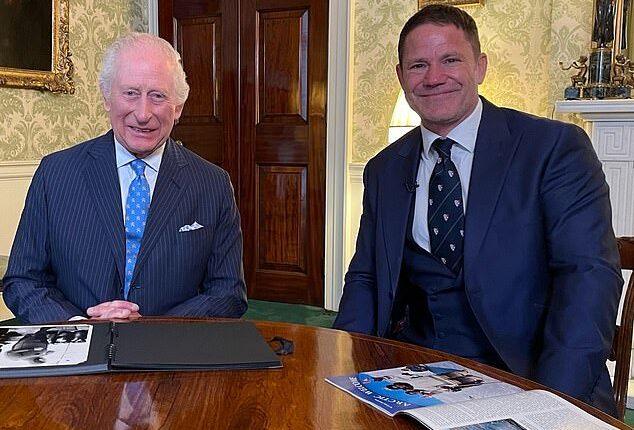King Charles will be seen ‘as never before’ as he teams up with adventurer Steve Backshall for a new documentary.
In a new 90-minute ITV documentary, to be shown as part of the channel’s Christmas schedule, the King will speak to Steve as the latter retraces the Royal’s steps from his 1975 trip to the Canadian Arctic.
The monarch, 76, is set to discuss the ‘devastating effects’ of climate change during his appearance in the programme, which is titled Steve Backshall’s Royal Arctic Challenge.
Steve’s journey comes exactly 50 years after the King’s expedition, which helped shape Charles’s passion for protecting the environment and his belief in the importance of living in harmony with nature.
Charles travelled to the Canadian Arctic when he was aged just 26 and still the Prince of Wales. While there, he took part in dog sledging and diving under the Arctic ice with Canadian researchers.
The then-Prince also spent the trip learning about the local Inuit people’s culture and dependence on the environment around them – even trying raw seal liver when it was offered to him.
Steve, 52, will look at the accelerating impact of climate change on the Arctic, which is warming three times faster than the rest of the world.
Marshall Corwin, who directed the documentary, added that it was ‘eye opening’ to see King Charles ‘as never before’, including the monarch’s ‘extreme spirit of adventure’, ‘genuine passion for the planet’ and ‘his mischievous sense of humour’.

The King will speak to Steve Backshall about the ‘devastating effects’ of climate change in a forthcoming ITV documentary. Pictured together in March at Buckingham Palace
Speaking about the project, Backshall said in a statement: ‘To see the Arctic through the King’s eyes – then and now – was both inspiring and sobering.
‘Standing where the King once stood, diving beneath the same Arctic ice he explored half a century ago, was humbling beyond words.
‘His Majesty was raising the alarm for the natural world long before most of us realised how urgent that call would becoming.
‘His commitment to protecting our planet runs through every fibre of this story.’
Nicky Cox, executive producer, also praised the King’s ‘decades-long dedication to the environment’, hailing it as ‘visionary’.
Charles’s 11-day royal visit in 1975 saw him landing first in Ottawa and spending three days in Canada’s capital region before travelling north.
The King carried out his dive under the ice with physician and researcher Joe MacInnis in Resolute Bay, which is known today as Nunavut.
Writing in the Canadian Geographic earlier this year to commemorate 50 years since the dive with the Royal, Joe recalled the moment he led the then-Prince into the freezing waters.
He said the 30-minute dive went smoothly, despite Charles initially struggling to control his buoyancy in his diving suit.

Charles, then the Prince of Wales, wears a special diving suit as he attempts to walk below the five-foot arctic ice in Canada, 1975
Towards the end of the dive, Joe said he prepared a black bowler hat and an umbrella for Charles to wear and hold on his ascent back up to the surface, as a joke.
Recalling the moment Charles, still underwater, saw him holding the hat and umbrella, Joe wrote: ‘He stares at me as if I’ve gone mad. My heart sinks. Seconds later, his eyes crinkle and the sound of muted laughter fills the space between us.
‘The prince puts the hat on, reaches for the umbrella, holds it over his head and slowly ascends towards the dive hole. Trailing a stream of bubbles, he is Mary Poppins in the flying nanny scene.’
Almost a decade after the expedition, Charles agreed to introduce a documentary about an 1853 shipwreck that Joe and other researchers had dived to film, titled The Land That Devours Ships.
In his introduction, Charles said: ‘A few years ago, I was lucky enough to visit the Canadian Arctic and to dive under the ice with Dr Joe MacInnis.
‘That was one of the most interesting and exciting things I have done for a considerable time.
‘It was that particular experience that helped me to discover why so many of those ships never came back from the great expeditions of the 19th century.

The King has long been passionate about environmental causes. Pictured in Canada in 1975
‘It was the loss of two of those ships, the Erebus and Terror, under the command of Sir John Franklin, that launched the greatest search in maritime history.
‘And it’s a search that’s continuing even today.’
Charles returned to Canada earlier this year with Queen Camilla by his side.
The King has consistently championed environmental awareness for decades, and still supports a number of causes today.
Earlier this month, the King and Prince of Wales appeared at a rare joint public engagement, brought together by their shared passion for the environment.
The monarch and his son, Prince William, visited the Natural History Museum in London for ‘Countdown to COP30′, which brings together organisations and individuals tackling the global environmental crisis and nature loss issues ahead of the United Nations’ annual climate change summit in Brazil in November.
The museum also showcased a film titled ‘The Speeches: 50 Years of Speaking Up for the Planet’ that looked back at the King’s legacy on the issue.
The King was also reunited with an old friend, Brazilian indigenous leader Chief Raoni Metuktire of the Kayapo people, in the past week.
The rainforest advocate – with his traditional lip plate and headdress – is a familiar figure on the world stage having campaigned for decades to save the Amazon rainforest. He was nominated for a Nobel Peace Prize for his work.
He was visiting the UK for the last time at the age of ‘approximately’ 93.
The King also met singer Larissa de Macedo Machado who told him she would be performing for his son, Prince William, at his Earthshot Prize awards in Rio next month, as well as iconic environmental campaigner Bianca Jagger – stylish in a white suit and Panama hat – who had been invited as a guest.







